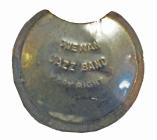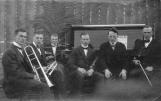1
The EntertainersLocal citizens have always enjoyed (mostly) every genre of music performed by all kinds of entertainers. This fine tradition continues today with many talented amateur and professional musicians including Ian Tyson, Keith Hitchner, Cindy Church, Amos Garret and many others calling the Highwood area home.
2
A group of performers on the stage of the Opera HouseCirca 1920
High River, Alberta, Canada
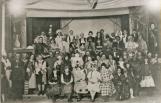 Credits:
Credits:Museum of the Highwood Archives, 979-026-015
3
Art Lacey's eight piece dance bandCirca 1940
High River, Alberta, Canada
 Credits:
Credits:Museum of the Highwood 989-073-043
4
High River Jazz Bands - early 1900sIn the late 1910s and the 1920s, a few men gathered together to form the High River Jazz Band. Although some members of the community were against jazz (because of its "suggestive" nature), the band became well known throughout southern Alberta. Under the direction of Len Davis, the band was composed of a cornet player, trombone player, a drummer, pianist, and violinist.
With the popularity of jazz mounting, another jazz band was formed. They called themselves the High River Cannoneers Jazz Band but this band did not fare so well. During a trip to Lethbridge, the band split up over a difference of opinion between the original leader, Mr. Kilborn, and the original members. The band had been scheduled to play a gig at the Knights of Pythias hall and the members decided to follow through on their obligation. The dance was to start at 9 p.m. but when the Cannoneers arrived they were met by an angry Mr. Kilborn - and a police officer. Two of the band members were arrested on suspicion of stealing a score of music and the remaining musicians had to leave the hall.
With their music taken away, the dancers' evening was in jepordy. They wanted to dance! Quickly, the dancers found themselves a lawyer and, after only a short discussion, bail was obtained for the arrested musicians. The musicians then rushed back to the hall where they were greeted by the waiting dancers with happy cheers. The men picked up their instruments and opened the evening with "Bluing of the Blues".
The charge was later withdrawn by Mr. Kilborn.
7
Music Makes Your Vegetables Grow?1920's
Alberta, Canada
Music Makes Your Vegetables Grow?
"W.H. "Dad" Fletcher of Brant will appear at an Old Timers' Fiddler Contest in Capitol Theatre in Calgary on Friday evening. Mr. Fletcher is 75 years of age. He has never studied a note of music in his life and has learned to play entirely by ear. The Calgary Herald, Speaking of him says: "At present he is taking a rest by farming at Brant, Alberta where he is more than a success. In addition to his grain farming, Mr. Fletcher makes a specialty of vegetable raising and is rumored that he grows his big cabbages by playing the fiddle to them."
- High River Times, April 1926
Credits:The Best Of Times, Vol 4, Published by Century Books, High River, (c) 2003
8
Odette de Foras - Opera SingerComte and Comtesse de Foras arrived in Canada from France in 1907. The Rocky Mountains reminded the couple of the French Alps and they decided to settle within their shadow.
They had six daughters and four sons and the younger members of the family attended school in High River. One of their daughters was Odette, a young girl who loved to sing. She would one day grow up to receive world acclaim in opera.
In 1916, Odette was excited to learn that she won a scholarship from the Associated Boards of the Royal College of Music and the Royal Academy of Music that would allow her to study vocal music in London. Unfortunately, she was unable to accept due to the danger of travelling during wartime. Because of her high degree of musical talent, officials granted a deferrment of her scholarship.
During the war she became more of a cowboy than a singer. She, and some other girls, took the place of enlisted men who had worked on her fathers ranch. She rounded up cattle and even branded them. She said that she could do "anything on horseback".
Finally, in 1919, Odette was able to travel to London. She studied voice under Signor Manuel Garcia. When money was tight, Alberta cattleman Senator Pat Burns generously donated to her education. Her scholarship was given an unprecedented extension to four years.
In 1922 Odette gave a student presentation of Madame Butterfly which won her great praise in the Daily Telegraph in London, England: "Her voice suits Puccini's music to perfection, and especially in the second act the all-round ripeness of her performance was astonishing." Her star was rising and the High River Times followed her journey, keeping High River residents in the know about their local celebrity.
For ten years Odette headed the Official Standards list of opera in Europe. She gave a command performance for King George and Queen Mary and seats sold for as high as 100 pounds each. When she took her bow, the audience gave her a standing ovation.
Despite her triumphs, she never forgot where she came from. She often traveled back to High River, and graced the High River Opera House with performances. She frequently sang 'My Little Gray Home in the West', saying that it was her mother's favorite song.
One well known story about Odette took place at the High River Opera House. During Odette's solo, a colourful High River woman named Miss Shackerley leaned forward. Suddenly her chair collapsed and she crashed to the ground. She carried a large supply of nickles and dimes in a sugar sack and these rolled all over the floor. Ever the professional, Odette carried on without blinking an eye. The audience tried their best to keep quiet, but faces grew red as supressed laughter fought to escape. One gentleman helped Miss Shackerly back into her chair, but just as the scattered coins were being collected, a small kitten jumped onstage, walked right over to Odette, sat down and stared up at the singer. Odette couldn't stand it any longer - she broke out into gales of laughter. Her audience joined in and it was quite some time before the concert resumed.
In the 1930's Odette came back to High River because of ill health. The Second World War broke out and she could not return overseas. She stayed and worked on the family farm, giving performances on the radio and doing some teaching. One High River resident remembers Odette coming to visit her parents, and when Odette sang the children would hang on to the clothesline "to keep the roof from flying off".
In January 1959 she sang to a packed Jubliee Auditorium. This comeback preformance showed that, dispite being away from the stage for 10 years, her talent was still well recognized.
Sadly, Odette's home in High River burned down in 1958. Along with priceless family heirlooms, all the memorabila from her time as a grand opera star went up in flames. As she watched her home and memories burn to the ground, firefighters remember hearing her sing "My Little Gray Home in the West".
9
Odette de ForasCirca 1920
High River, Alberta, Canada
 Credits:
Credits:Museum of the Highwood Archives 999-040-013
10
Don King's Memoirs - Odette de Foras1926-1960
High River, Alberta, Canada
Don King's Memoirs - Odette de Foras
My friendship with Odette began in the late 1940's when I was working a clerk in Waltham Hardware. Several recently graduated school friends had obtained work in various stores and businesses in downtown High River and it was our habit to go together for coffee (actually it was hot chocolate), choosing a different café each week. (these were the New Look Café, the St. George Hotel's coffee shop, and the City Café.) On leaving Waltham's by the back door I would head South along the alley, past the back door of the New Look Café and at ten o'clock (our coffee time), would meet a person there who was in the act of loading the cafe's liquid garbage (swill) from the collecting barrels into 45 gallon drums in the box of an old half-ton truck - by bucket.
Our first few words to each other were in the form of greetings - good morning, nice day, etc, but for a few days I didn't know if the person was a man or a woman - stocky, fairly short, dressed in bib overalls, rubber boots and a man's checked shirt and old fedora hat, and speaking with a low voice. After a few days I discovered that it was a woman and we struck up an acquaintance, always pausing to chat a moment - I discovered also that she owned and operated a pig farm just west of High River and that she was the daughter of Count and Countess deForas, both deceased, leaving the farm to the daughter - Odette.
Credits:Museum of the Highwood, Don King's unpublished memoirs, "The Time of My Life", 2003
11
Odette de Foras at the Memorial CentreCirca 1958
High River, Alberta, Canada
 Credits:
Credits:Museum of the Highwood Archives 989-001-758
12
Program for Odette de Foras recital - outside16 January 1959
Calgary, Alberta, Canada
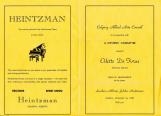 Credits:
Credits:Museum of the Highwood Archives 983-039-003
13
Program for Odette de Foras recital - inside16 January 1959
Calgary, Alberta, Canada
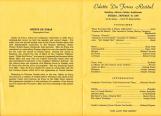 Credits:
Credits:Museum of the Highwood Archives 983-039-003
14
Odette de Foras singing at Roy and Lenore McLean's weddingCirca 1950s
High River, Alberta, Canada
 Credits:
Credits:Museum of the Highwood Archives 989-001-515
